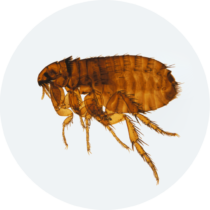Fleas
Fleas are a serious problem in homes especially for those with cats or dogs. While fleas can transmit disease, they are also frequently found when moving into a home that previously had pets.
There are many species of flea, most are 2 – 3mm long and red or brown in color. Adult fleas pierce the skin of mammals or birds to feed on blood. However, flea larvae feed on organic matter in carpets or bedding and so high levels of hygiene can slow the life – cycle.

Flea cocoons can remain dormant for two years or more and are awoken by the vibration of footsteps. It is very common for a flea infestation to remain dormant in an empty home but to awaken when people move in.
Human Fleas have developed to specialize on different animals, but the human flea that lives on people (and some animals with similar skin) is rarely common on cities. They can be found exceptionally around farms where human fleas are found on pigs and these can jump to humans. Human fleas will bite anywhere on the body and are associated with itchiness as fleas crawl over the skin.
Cat fleas will bite humans, but they do not live on the human body. They will bite the hands and body when handling pets or pet bedding, but the most common place for flea bites are the feet and lower legs. There are usually many more fleas living on carpets and pet bedding than on the pets themselves; they will jump up and bite people as they come close.
Actual Size: 3.1 mm
Characteristics: Reddish-brown, wingless, laterally compressed.
Legs: 6
Antennae: Yes
Wings: No
Habits:
- Parasites that feed only on the blood of warm-blooded hosts.
- Thrive in many climates but prefer moist, humid, and shady areas.
- Inside homes, larvae will live in carpets, bedding, pet beds, and upholstered furniture.
Flea Habitat
Fleas thrive in many climates but prefer moist, humid, and shady areas. The area underneath a porch or deck can turn into an overwintering site. Areas with tall grass, leaf litter, weeds, wood piles, gravelly areas, and sandy patches are all attractive to fleas. Even the tiniest crack in the concrete can harbour fleas and they especially shrubs, leaves, and trees, but do not fare well in sunny areas or open grass. Fleas usually enter structures attached to pets, and they can quickly find refuge in homes. Flea larvae do not like the light so carpets, bedding, pet beds, and upholstered furniture make cozy homes for fleas, flea eggs, and flea larvae.


